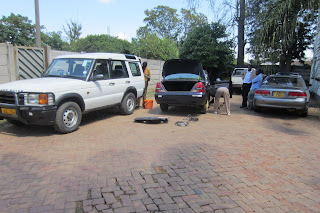 I found all the technology hiding in the private practice world of Zimbabwean health care.
I found all the technology hiding in the private practice world of Zimbabwean health care. As in many other countries, there is 2-tier health care with (1) government, public sector that is sliding scale and (2) the private practice world with increased access, costs, efficiency, and quality of care. In both cases, it's pay-as-you-go or hope your Medical Aid (insurance) covers you. Medical Aid doesn't reimburse physicians very well, and not everybody takes it... hmmm, sounds familiar? If government doesn't have what you need, you can separately purchase it from "in private." Need lamotrigine? MRI spine? Myasthenia antibody tests? You guessed it, I'll write you a req to get it in private.
As in many other countries, there is 2-tier health care with (1) government, public sector that is sliding scale and (2) the private practice world with increased access, costs, efficiency, and quality of care. In both cases, it's pay-as-you-go or hope your Medical Aid (insurance) covers you. Medical Aid doesn't reimburse physicians very well, and not everybody takes it... hmmm, sounds familiar? If government doesn't have what you need, you can separately purchase it from "in private." Need lamotrigine? MRI spine? Myasthenia antibody tests? You guessed it, I'll write you a req to get it in private.
My mentee, Andrew, took me to the private Baines/MRI institute for a meeting with Dr. Nayak, the only neuroradiologist around (trained abroad, used to work as a professor in Canada). He is great and although private, has a semi-academic stance. He set up imaging for Parirenyatwa (the University hospital where I have been working). Currently, University CT scan needs repair of a part, and has been down for the better part of a year with no recovery date in sight. An MRI machine Dr. Nayak helped set up some years ago ran out of helium years ago during a helium shortage and was obsolete by the time everything was available. So, now, if you want imaging, you ask the patient to "organize funds" and obtain "in private." I have been referring all the patients to Dr. Nayak, since he can do the MRI cases I really need for $500. He is trying to compete with cheaper CT scans because he sees so many low-yield CTs done when an MRI would have given the answer. He is willing to do pro bono because he is so sincere about cases that need urgent imaging.

He also runs weekly neuroradiology conferences with invited neurosurgeons and interested residents, and this week -- a neurologist :) The neurosurgeon brought some spine cases of patients who he had done EMG. Unclear how he was trained. Dr. Nayak showed some cool cases from exotic to bread and butter. See if you can guess the diagnosis of this 23 year old female with first time seizure. Answer.













































